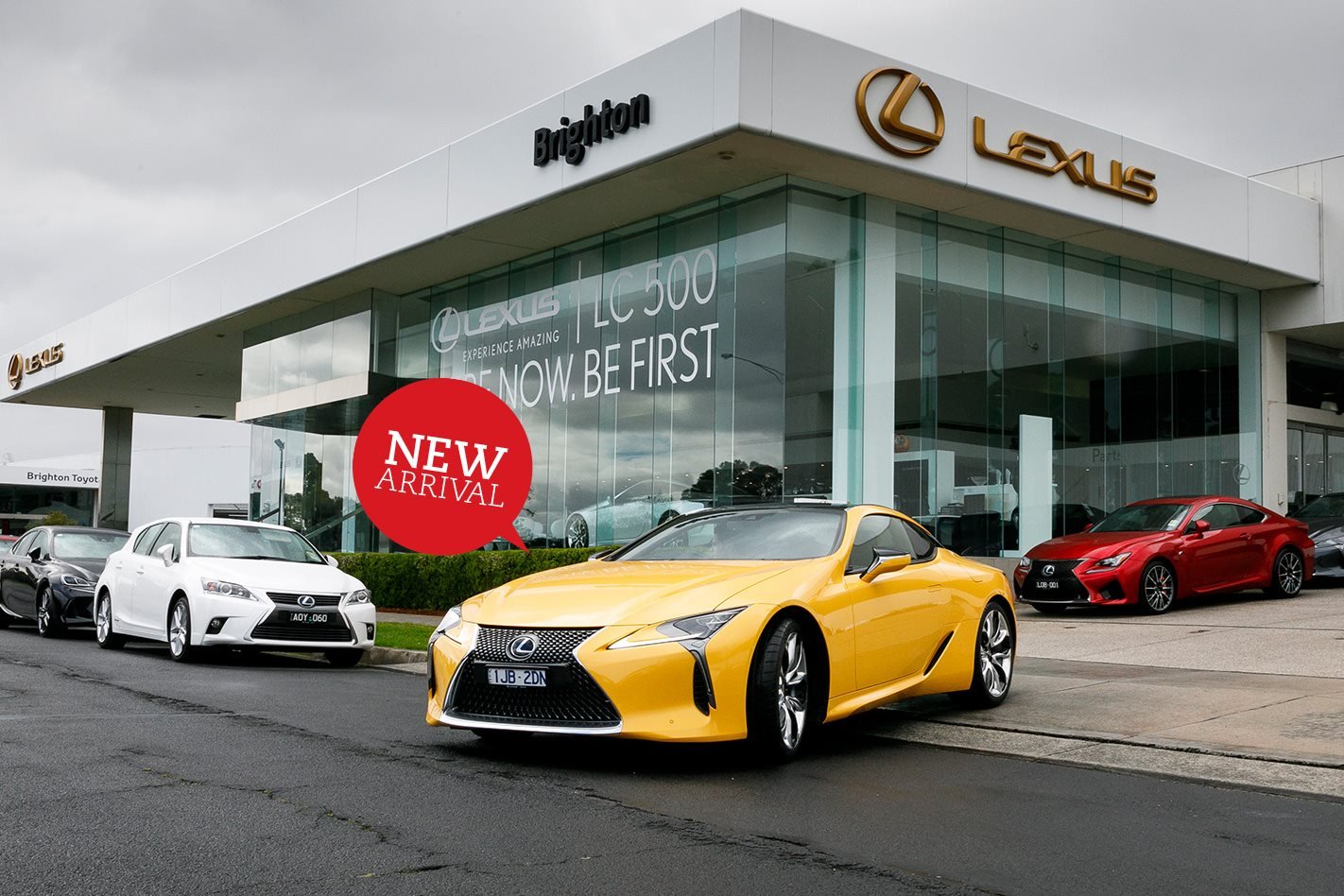
I’ve helped others do it, and taken joy in advising them on spec and trim levels, but for myriad reasons (headlined by a crippling dread of depreciation), I’ve always gravitated towards second-hand metal when it came to my own wheels.
This means I’ve never experienced that ‘new-car feeling’ – the heady combination of elation, suspense and fear that comes with making a significant financial investment – so it was a thrill when, after agreeing to loan Wheels this searing yellow Lexus LC500 for three months, Lexus suggested I collect the car as a real customer.
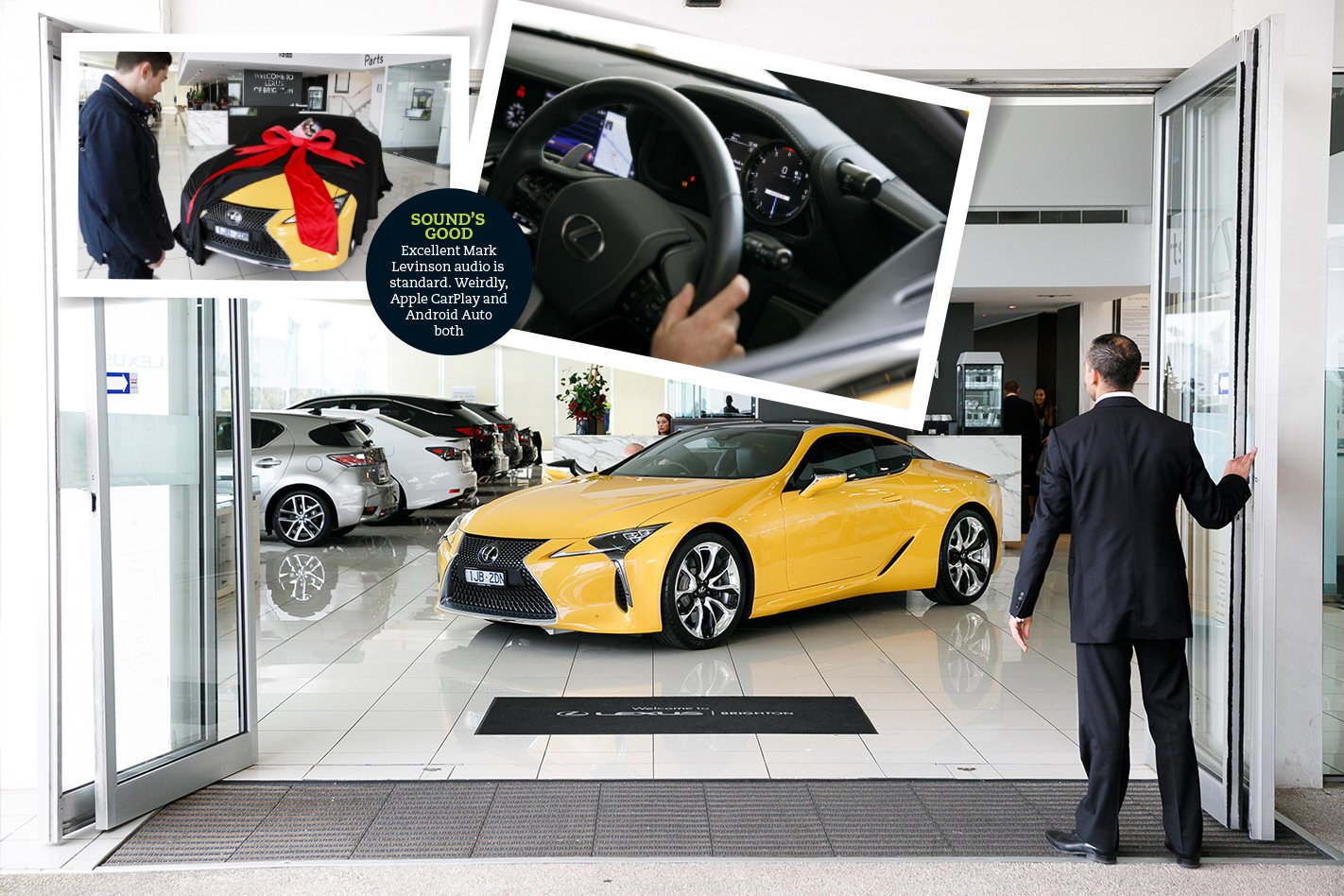
Toyota’s luxury arm is renowned for its dealership experience, so taking delivery would allow me to see if that reputation is deserved, as well as scratch a personal itch.
My LC500 is cloaked in a shiny black cover when I arrive at Lexus Brighton, and even with its details shrouded, the big rear-drive coupe oozes intent. Long, wide and classically proportioned, it’s also imposingly vast in the metal (overall length is 4760mm, while width is 1920mm).
Peeling away the cover enhances the drama. Yellow wouldn’t be my first choice (I think silver is more cohesive as it helps disguise some of the LC’s heavy-handed detailing, like the chrome finish atop the tail-lights) but there’s no denying its impact – I can’t think of a car this side of a Lamborghini that makes more of a visual statement.
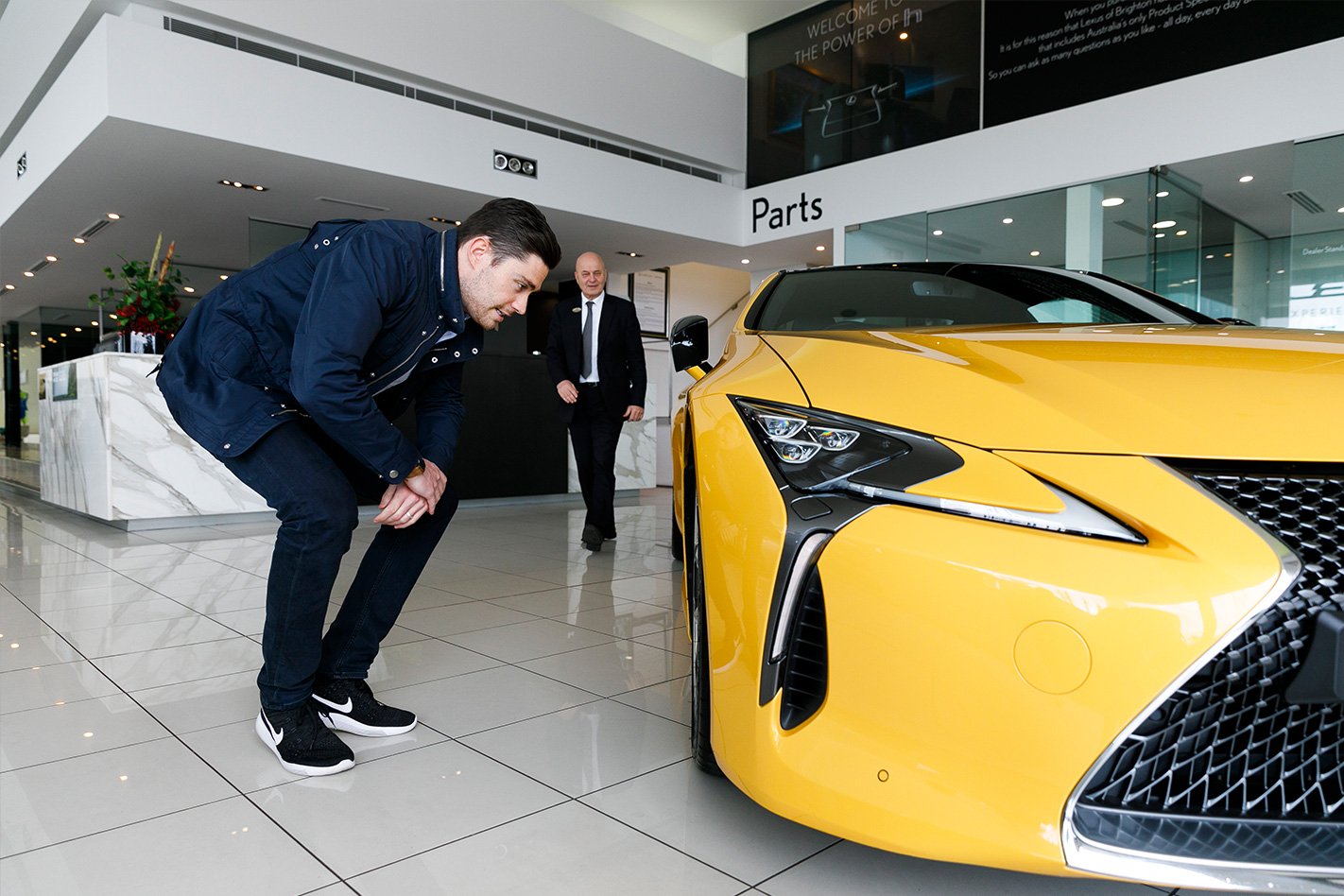
Bernard, who has a heavy French accent, a penchant for Italian motorcycles and an obvious passion for the LC, conducts the handover process. It begins with a walk around the exterior, where I take in the enormous 21-inch wheels (shod with Michelin rubber 245/40 front, and 275/35 rear) and discover the hidden boot release button (disguised inside the right rear tail-light) before we slip into the cabin.
If the exterior is all about impact, things are much more restrained inside my example.
Coloured leather options are available, but here it’s black-on-black from floor mat to roof lining, and that’s exactly how I’d spec it. First impressions are bang on too: the driving position is low and natural, the leather seats supple and supportive (as well as heated and cooled) and the fit and finish is staggering.

Material quality is another highlight, as is the digital dash that glows white when Sport+ mode is engaged, which is an obvious nod to the LFA supercar.
The only negative is the same fastidious attention to detail has been applied to the LC’s infotainment system, with confusing results.
Lexus has persisted with its maligned touch-pad controller rather than a touch-screen (at least the dorky mouse is gone!), but the real problem lies with the infotainment software. It’s a maze of menus and sub-menus and provides the only hiccup of the handover process when Bernard gets lost down a rabbit hole while explaining the sat-nav. Fingers crossed things improve with practice.

Happily, driving the LC is much more intuitive. As the first Lexus to utilise the company’s all-new Global Architecture – Luxury (GA-L) platform, it feels impressively rigid and refined at city speeds with a surprisingly supple and controlled ride, but it’s the old-fashioned 5.0-litre quad-cam V8 that dominates the experience.
Crisp, muscular and with an insatiable appetite for revs, it sounds brilliant and has a noticeable step change in volume and timbre as the tacho sweeps past 4000rpm. Yet the noise and effortless performance are only part of what makes driving the LC such an experience.
The remainder comes from the looks and reactions its concept-car design generates from other road users and pedestrians. It makes you feel special, and that’s exactly what a new car should do.
It’s going to be a good three months.
Update #2
SOMETHING good is happening at Lexus.
After years of building cars designed to appeal to the rational side of our brains, or to people who enjoy golf and lawn bowls, the company is steadily shaking free of its snoozer shackles.
My first encounter with this shift in philosophy came a few years ago at the launch of the then-new Lexus RC F in America. Lexus had taken the bold step of holding the event at a circuit, and while the RC F wasn’t quite as sharp as a BMW M4 or AMG C63 (blame a circa 2000kg kerb weight), its rev-hungry V8 and desire to blaze its rear rubber to smithereens left an indelible mark.
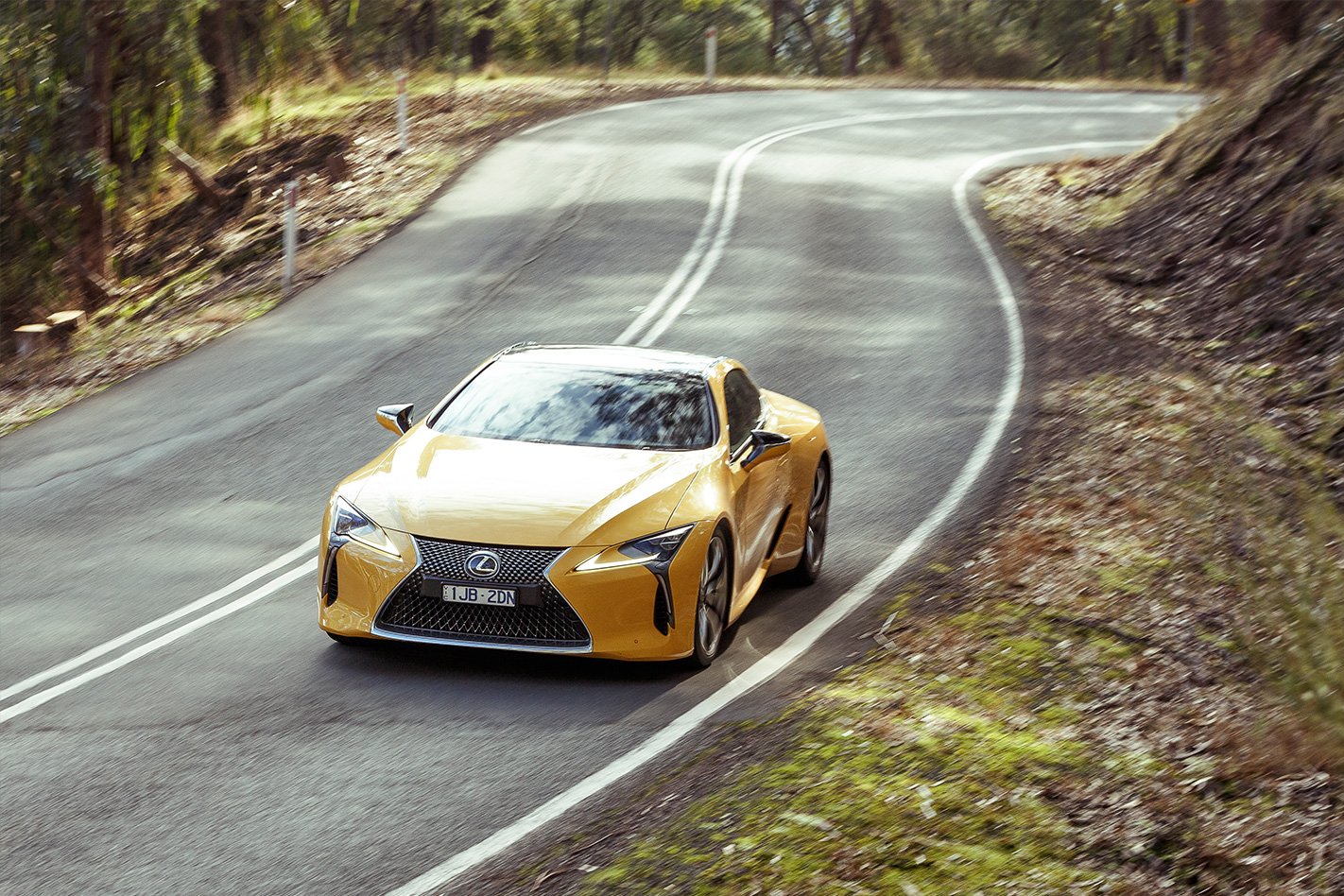
It wasn’t just exciting; it was fun too.
Then came an entire day at Sandown with a Lexus LFA, which didn’t just vaporise any preconceptions I had about the brand, but forever etched the howl of ten screaming cylinders into my brain as the digital tacho crested 9000rpm.
My bright yellow LC is further proof that the foundations are shifting, if gradually, at Lexus HQ. While last month was spent in Comfort mode, where I marvelled at the hushed cabin and surprisingly supple and controlled ride on those huge, concept-car wheels, month two has seen me explore the LC’s angrier side by toggling the drive-mode selector to Sport+.

The change it brings is dramatic and unexpectedly shouty. Suddenly the big 5.0-litre V8, which had been happy to quietly rustle into life and slip effortlessly through city traffic, feels razor sharp and, with your right foot planted, verges on manic. Even the 10-speed automatic gearbox comes to the party, with upshifts hammered home with an authority and speed that isn’t far off a dual-clutch.
The real highlight, however, comes when you pull the left shift paddle and discover downshifts aren’t just as fast, but are surprisingly crisp. The noise is brilliant too: I’ve found myself cycling through the gears just to hear the big V8 roar and then crackle and gargle on the overrun.
It has soul this engine.

Lexus could have followed the downsizing trend and fitted the LC with the twin-turbo V6 found in the new LS, but I’m glad it didn’t. The V8 gives the LC the personality it needs to match its futuristic styling. It feels like a muscle car which, given its hefty 1920kg kerb weight, wide 275-section rear tyres and healthy thirst, it kind of is.
And who’d have thought that about a Lexus?
Update #3
IT CAN be cruel and pitiless, COTY testing. Having run this long-term LC500 for the previous two months, I was keener than most to see how the big Japanese muscle car would perform at our toughest week of the year.
I was, justifiably I’d say, optimistic of the LC’s chances. Striking to look at, superbly made and luxuriously comfortable, it’s even possible to argue the LC is decent value considering its wow factor, size, quality and performance.
The addition of the Hybrid model, which uses a fiendishly complex powertrain to boost performance and economy, appears to have COTY’s technology criterion covered off too.

It seems counter-intuitive, I know, given its instant visual appeal, but it’s the nuances and quirks that make the LC so interesting to live with and, by comparison, make other cars feel a little one-dimensional.
The endless maze that is the infotainment system, for example, which was baffling and complicated initially, has become a challenge and a surprise as I continue to discover new shortcuts and menus even after months of use. And I love that all the dials and buttons feel metallic and expensive, like a high-end hi-fi.
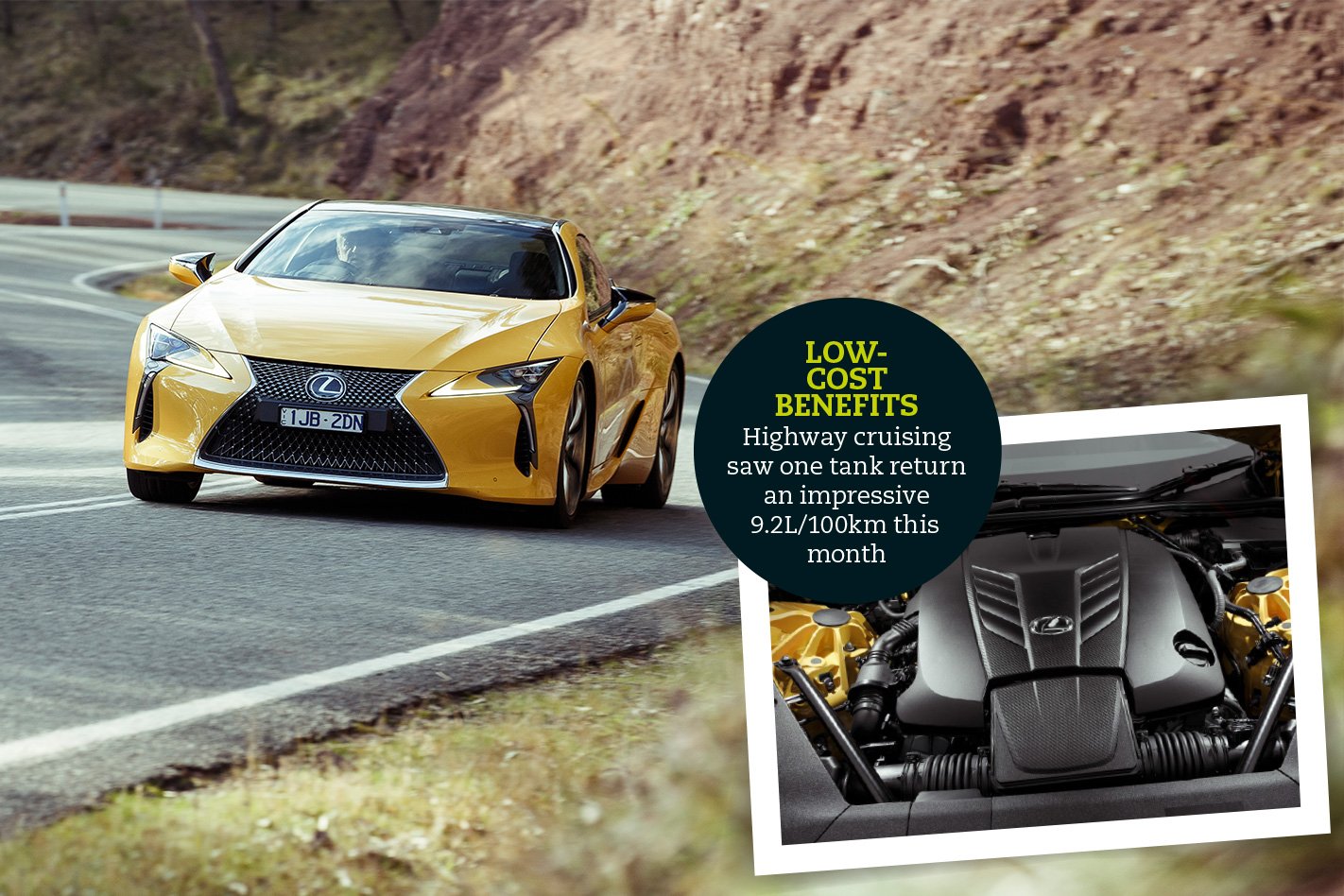
Even the dynamics have surprising bandwidth, with each driving mode (including a Custom setting I only discovered this month that allows optimal configuration of chassis and powertrain) revealing different shades of character and ability.
It’s a car with layers, and that’s partly why I’ll be so disappointed to see it go. Having occupied my driveway for three months, come next week, my yellow LC500 will be replaced with a red one that, beyond the colour change, should look identical bar a small ‘h’ added to its badging.
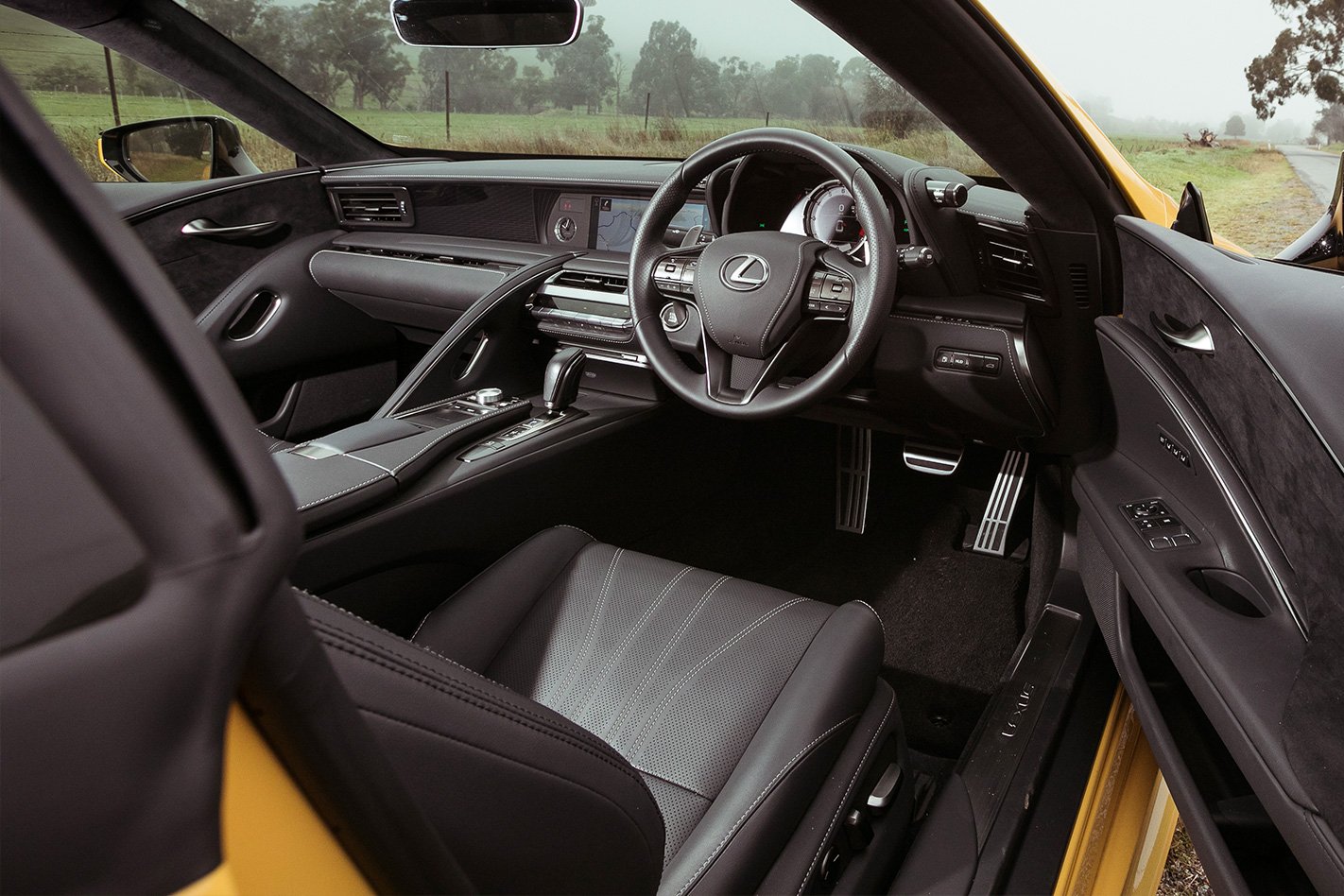
I fear I’ll be taking a step backwards. Here’s hoping I’m wrong.
Farewell
AS MUCH as I’d like to think I’m immune to the common human failing of making poor decisions, the arrival of this rather beautiful red Lexus LC 500h proves that alas, I am not.
Having spent the last three months in the burly, brilliant and rather boisterous V8-powered Lexus LC500, the decision to swap it for the hybrid version for the final month of the LC’s long-term loan seemed a smart one.
After all, the two cars are identically priced and the hybrid’s complex drivetrain intrigued me. Can an aspirated V6 petrol mated to a lithium-ion battery and electric motor really compare to the character, noise and fire-and-brimstone performance of the V8? And if it couldn’t, would it deliver enough of an efficiency boost to justify the sacrifice?
It doesn’t take long to realise that, despite its identical exterior appearance, the hybrid is a very different proposition to the V8. The changes are subtle at first. The starter button, for example, is a bluey-purple colour, not silver like the V8’s, and prodding it doesn’t bring the deep burble of internal combustion I’m used to, but eerie silence.
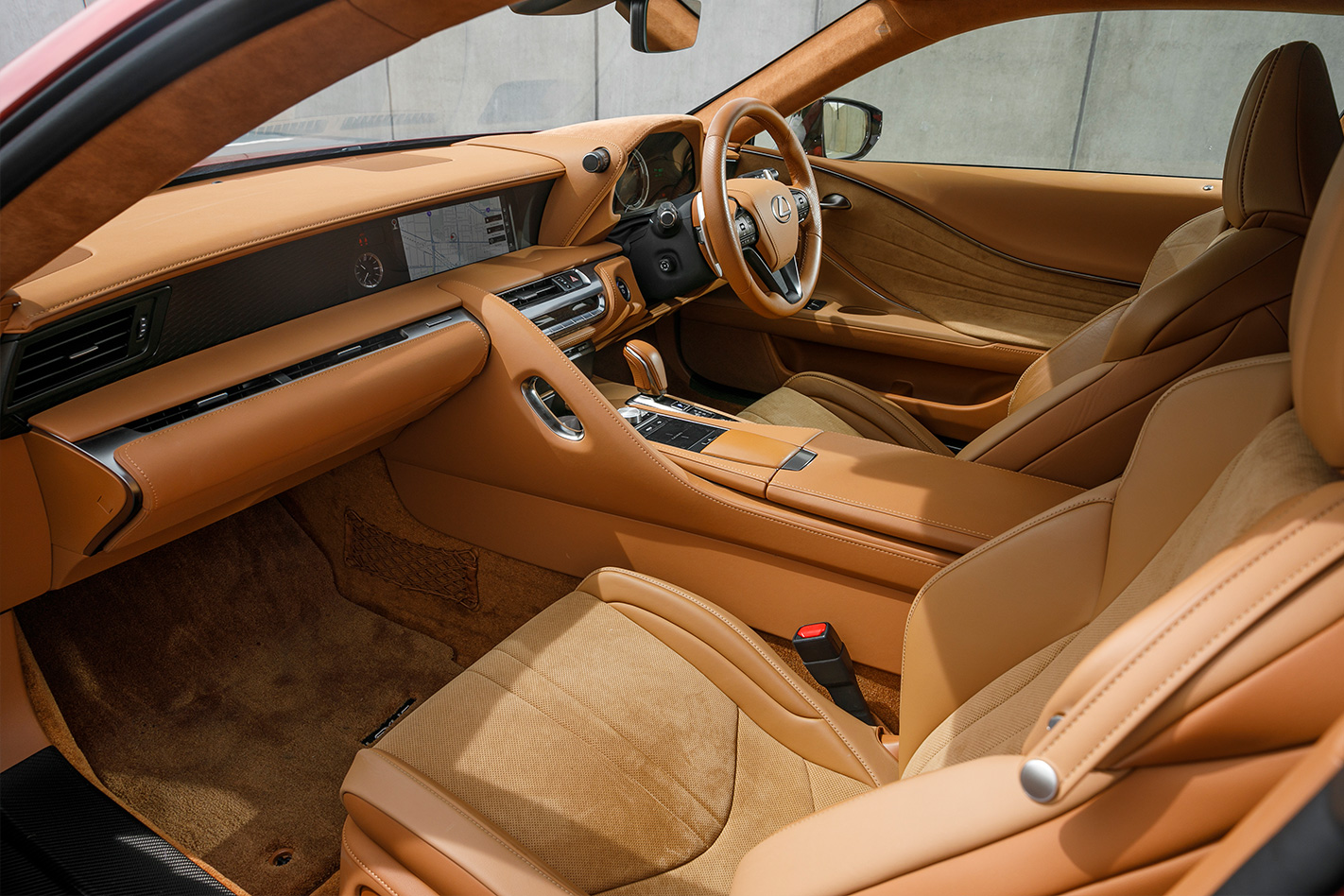
This continues as I roll out of the carpark but then, as I feed in more throttle to join the traffic flow, the charmless drone of the V6 ignites with a jolt. The brake pedal feels different too, with that trademark Toyota hybrid fizzing sensation at the top of the travel.
Even the steering, which is darty in comparison, takes some adjustment, thanks to its variable-ratio rack that comes as part of this particular car’s optional Enhancement Package.
The $15K pack also adds four-wheel steering, an active rear wing and some interior tweaks, such as replacing the V8’s sublime leather seats with heavily bolstered cloth pews, which for my frame at least, aren’t as comfortable. Small differences, sure, but combine them and the hybrid feels a noticeable step backward from the V8; a feeling magnified by the fact that the rest of the car feels so familiar.
Further exploration of the powertrain as I accelerate onto the freeway only solidifies the realisation that I’ve made an error in my decision-making process: I should have driven the hybrid first, then the V8.
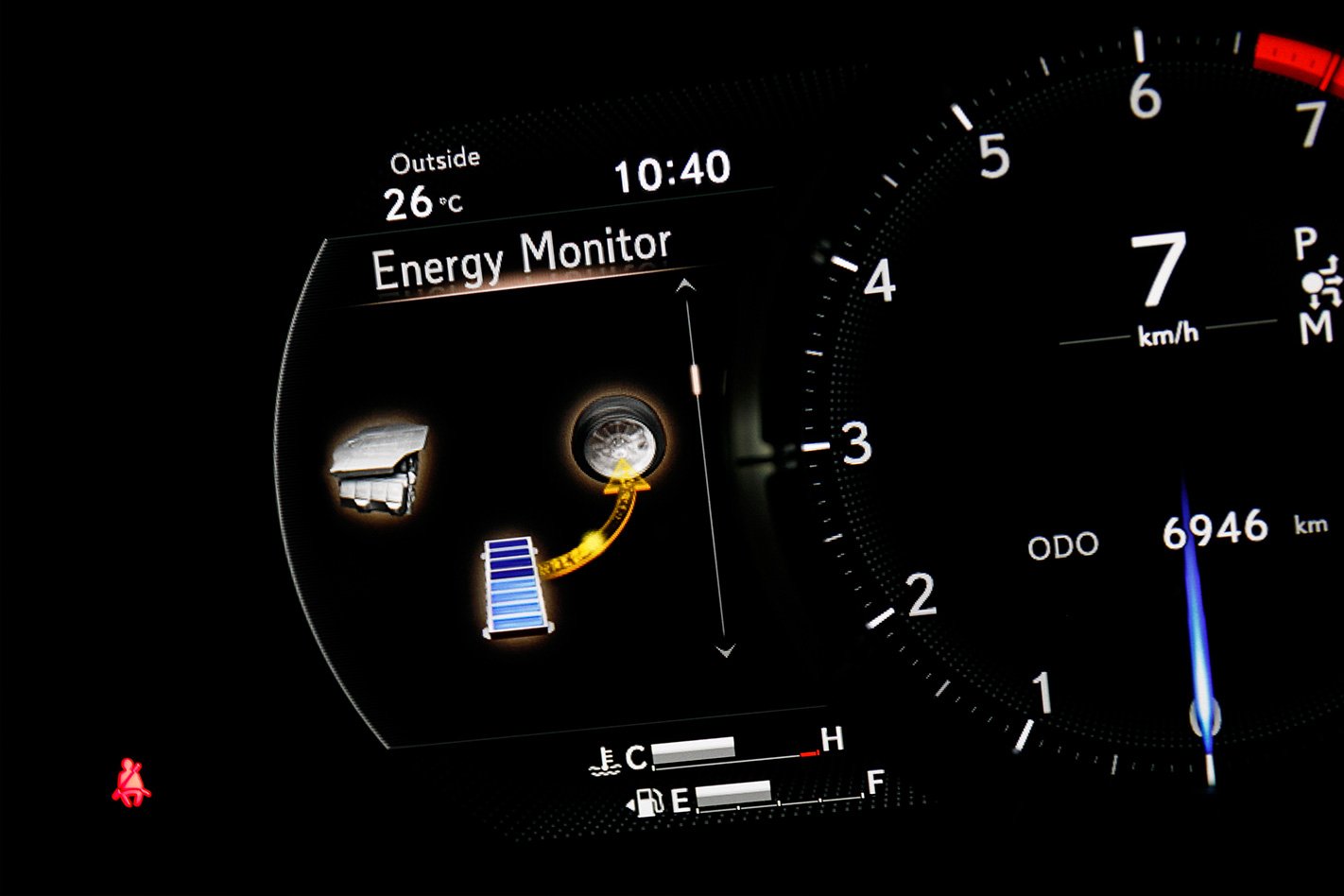
While much of the LC core goodness remains – head turning looks, brilliant build quality, surprising value and excellent ride comfort – constantly comparing the hybrid to the V8 only highlights its shortcomings. Had I driven them the other way around, perhaps I’d be less disappointed.
Weeks of familiarisation haven’t softened my resolve either. While surprisingly swift, especially off the line, thanks to its instant electric shove, the 264kW/348Nm hybrid lacks the theatre and rush that makes the LC 500 so engaging.
There’s none of the V8’s effortlessness either, with squeezes on the throttle exposing the V6’s lack of torque (the 500h also weighs about 50kg more) and slower downshifts from the hybrid’s complex gearbox, which combines a conventional four-speed automatic with a CVT. It has little of the crispness or intuition of the V8’s 10-speed torque converter automatic and occasionally delivers unnatural feeling, slurring upshifts where revs don’t quite match the road speed or throttle position.
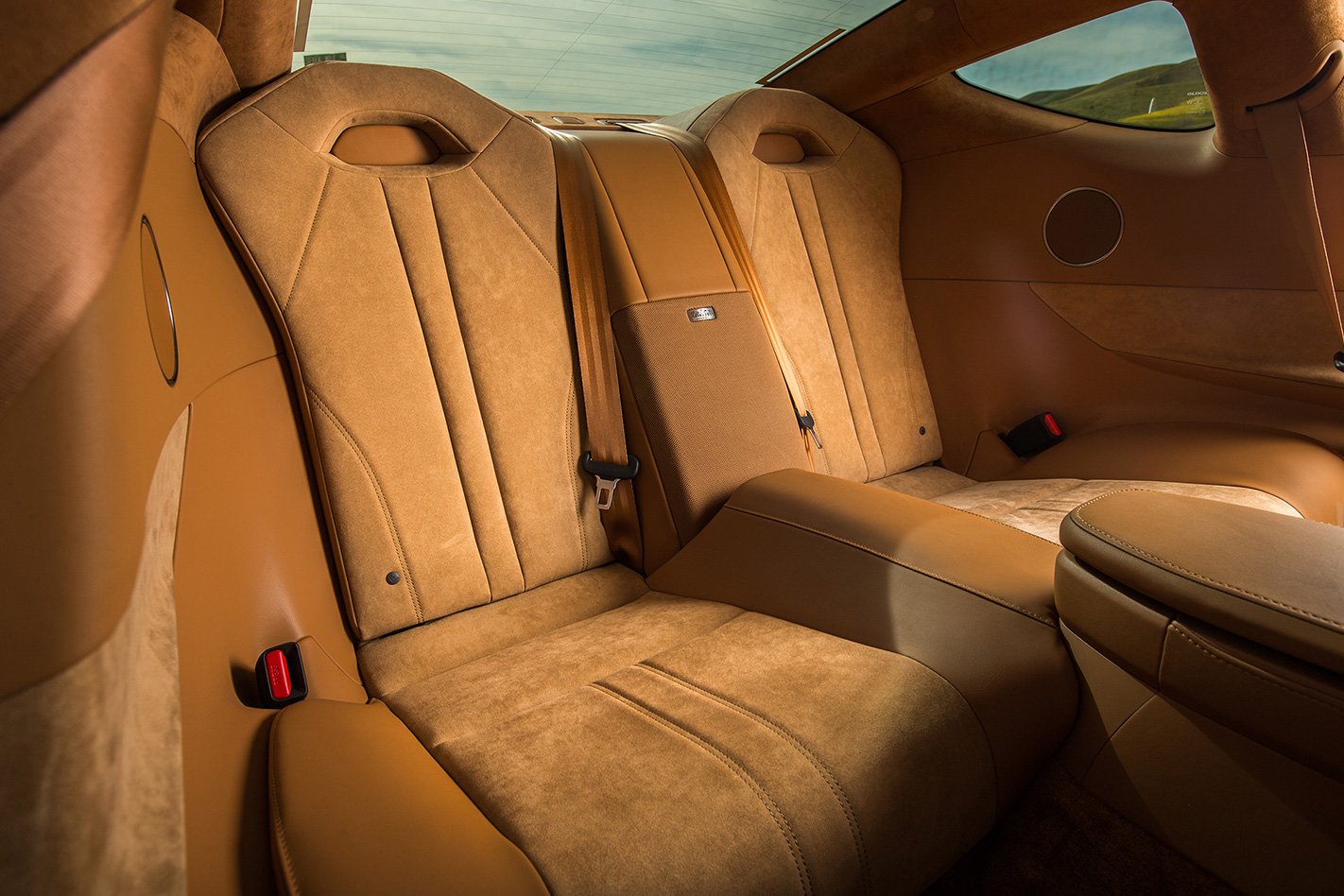
I’m not convinced by the $15K Enhancement Package either. The standard seats are better, so is the variable rack and I could take or leave the four-wheel steering, which does deliver a welcome manoeuvrability boost at low speed, but can feel a heartbeat behind the rest of the car when driving quickly.
So the V8 is the LC to buy, but even with the hybrid’s less satisfying powertrain, both models retain an appeal and personality that’s quite unlike any other car. Core to this are those outlandish looks, which, even after four months, still deliver a thrill every time I walk up to the driver’s door.
The only real LC negatives are the overly complicated infotainment system and the shallow boot (172 litres in the hybrid; 18L less than the V8), but even these can’t detract from what is a unique, soulful and engaging sports coupe that, like most Lexus performance cars, only gets better the more time you spend with it.




